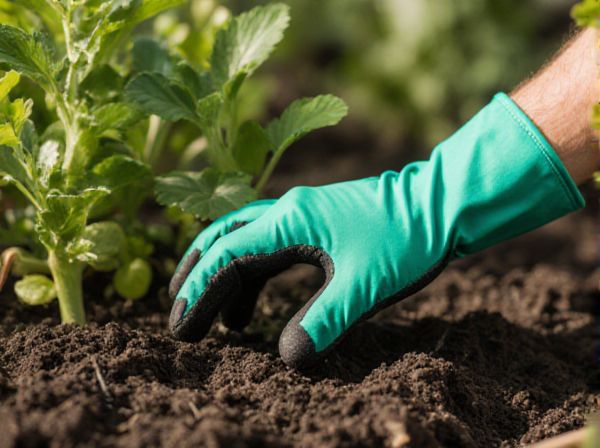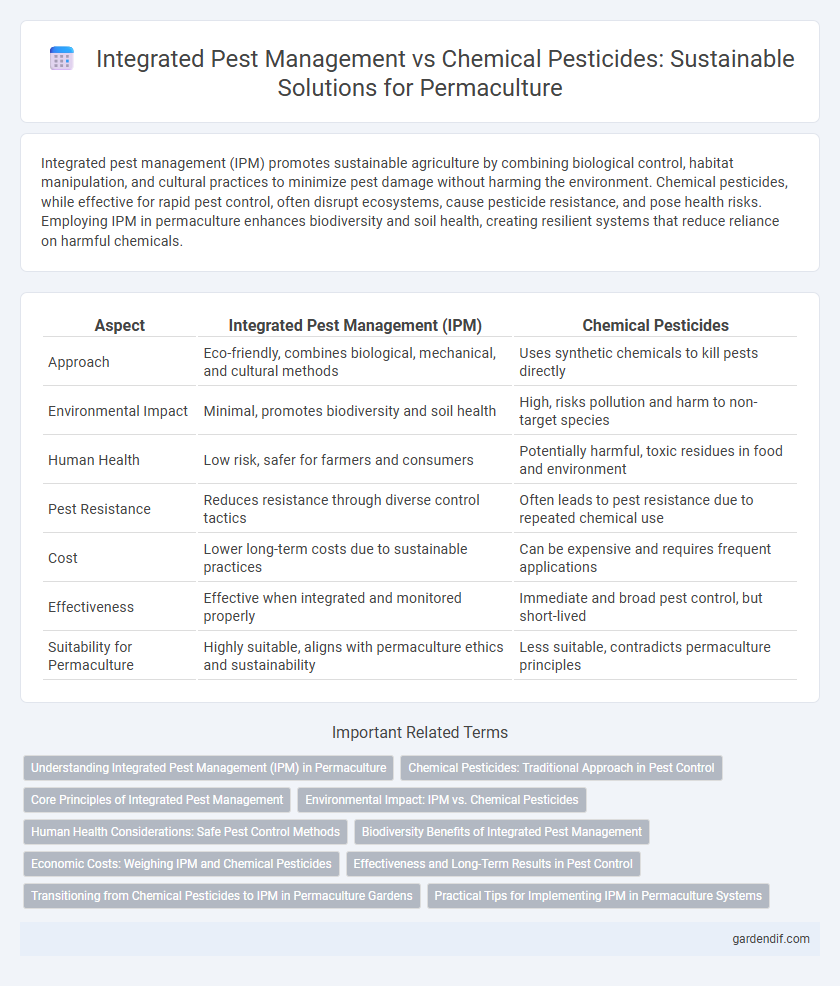
integrated pest management vs chemical pesticides Illustration
Integrated pest management (IPM) promotes sustainable agriculture by combining biological control, habitat manipulation, and cultural practices to minimize pest damage without harming the environment. Chemical pesticides, while effective for rapid pest control, often disrupt ecosystems, cause pesticide resistance, and pose health risks. Employing IPM in permaculture enhances biodiversity and soil health, creating resilient systems that reduce reliance on harmful chemicals.
Table of Comparison
| Aspect | Integrated Pest Management (IPM) | Chemical Pesticides |
|---|---|---|
| Approach | Eco-friendly, combines biological, mechanical, and cultural methods | Uses synthetic chemicals to kill pests directly |
| Environmental Impact | Minimal, promotes biodiversity and soil health | High, risks pollution and harm to non-target species |
| Human Health | Low risk, safer for farmers and consumers | Potentially harmful, toxic residues in food and environment |
| Pest Resistance | Reduces resistance through diverse control tactics | Often leads to pest resistance due to repeated chemical use |
| Cost | Lower long-term costs due to sustainable practices | Can be expensive and requires frequent applications |
| Effectiveness | Effective when integrated and monitored properly | Immediate and broad pest control, but short-lived |
| Suitability for Permaculture | Highly suitable, aligns with permaculture ethics and sustainability | Less suitable, contradicts permaculture principles |
Understanding Integrated Pest Management (IPM) in Permaculture
Integrated Pest Management (IPM) in permaculture emphasizes using natural predators, crop diversity, and habitat manipulation to control pest populations sustainably. This approach reduces reliance on chemical pesticides, minimizing environmental impact and promoting biodiversity. Effective IPM strategies include monitoring pest levels, encouraging beneficial insects, and implementing cultural practices that disrupt pest life cycles.
Chemical Pesticides: Traditional Approach in Pest Control
Chemical pesticides, a traditional approach in pest control, rely on synthetic compounds to eliminate or deter pests rapidly, often leading to immediate crop protection. These substances can persist in the environment, causing contamination of soil and water while harming non-target species such as beneficial insects and pollinators. Overuse of chemical pesticides contributes to pesticide resistance, necessitating higher doses or more toxic formulations, undermining long-term agricultural sustainability.
Core Principles of Integrated Pest Management
Integrated Pest Management (IPM) prioritizes ecosystem balance and sustainable pest control through core principles such as monitoring pest populations, using biological controls like beneficial insects, and implementing cultural practices to reduce pest habitats. Unlike chemical pesticides that rely on synthetic toxins causing environmental harm and resistance buildup, IPM emphasizes targeted interventions only when pest levels exceed economic thresholds. This approach enhances soil health, preserves biodiversity, and minimizes chemical residues in food and water systems, making it essential for resilient permaculture design.
Environmental Impact: IPM vs. Chemical Pesticides
Integrated Pest Management (IPM) minimizes environmental harm by using biological controls, habitat manipulation, and organic methods, significantly reducing chemical residues in soil and water. Chemical pesticides often contaminate ecosystems, leading to biodiversity loss, soil degradation, and water pollution through toxic runoff. IPM promotes sustainable agriculture by maintaining ecological balance and reducing dependency on synthetic chemicals that disrupt natural pest predators.
Human Health Considerations: Safe Pest Control Methods
Integrated pest management (IPM) emphasizes biological controls and habitat manipulation to minimize pesticide use, significantly reducing toxic exposure risks to humans. Chemical pesticides often contain harmful compounds linked to respiratory problems, skin irritation, and long-term neurological effects. Prioritizing IPM techniques promotes safer pest control, protecting human health while maintaining ecological balance.
Biodiversity Benefits of Integrated Pest Management
Integrated Pest Management (IPM) enhances biodiversity by promoting natural predator-prey relationships, reducing reliance on harmful chemical pesticides that disrupt ecosystems. IPM strategies, such as crop rotation, biological controls, and habitat diversification, support beneficial insects, soil microorganisms, and pollinators that contribute to a balanced and resilient permaculture system. This biodiversity fosters pest suppression, improves soil health, and enhances overall ecosystem stability compared to the monoculture and chemical dependency associated with conventional pesticide use.
Economic Costs: Weighing IPM and Chemical Pesticides
Integrated Pest Management (IPM) reduces long-term economic costs by minimizing pesticide use and promoting natural pest control through biological agents, crop rotation, and habitat manipulation. Chemical pesticides often incur higher expenses due to frequent applications, resistance development, and potential environmental remediation. IPM strategies enhance sustainability and financial efficiency by lowering input costs and preserving ecosystem services essential for productive agriculture.
Effectiveness and Long-Term Results in Pest Control
Integrated pest management (IPM) in permaculture leverages biological controls, habitat manipulation, and organic techniques to maintain pest populations below damaging levels while preserving ecosystem health. Chemical pesticides offer immediate effectiveness but often lead to pest resistance, non-target species harm, and soil degradation, undermining long-term pest control sustainability. Sustainable IPM emphasizes resilience and ecological balance, yielding consistent pest suppression without compromising soil fertility and biodiversity.
Transitioning from Chemical Pesticides to IPM in Permaculture Gardens
Transitioning from chemical pesticides to integrated pest management (IPM) in permaculture gardens enhances biodiversity and soil health by utilizing natural predators, cultural practices, and mechanical controls to manage pests. IPM minimizes chemical residues and environmental toxicity, promoting ecosystem stability and long-term sustainability. This shift supports resilient food systems by reducing reliance on synthetic inputs and fostering self-regulating pest control mechanisms.
Practical Tips for Implementing IPM in Permaculture Systems
Integrated Pest Management (IPM) in permaculture emphasizes practical strategies such as habitat diversification, biological control using beneficial insects, and regular monitoring to minimize pest outbreaks without relying on chemical pesticides. Utilizing companion planting, crop rotation, and physical barriers enhances ecosystem resilience and pest suppression naturally. Consistent observation and timely intervention allow for targeted, low-impact treatments, ensuring sustainable pest control aligned with permaculture principles.
integrated pest management vs chemical pesticides Infographic

 gardendif.com
gardendif.com